#wagb
Explore tagged Tumblr posts
Text
WhatsApp Mod: Bahaya dan Risiko Penggunaannya

INFOBELITUNG - WhatsApp adalah aplikasi pesan instan yang populer dan digunakan oleh jutaan orang di seluruh dunia. Namun, beberapa pengguna mungkin ingin mencoba aplikasi WhatsApp modifikasi atau WA Mod untuk menikmati fitur-fitur tambahan yang tidak tersedia di aplikasi resmi. Namun, penggunaan aplikasi Whatsapp GB memiliki risiko yang lebih besar dan dapat menyebabkan akun Anda di blokir oleh WhatsApp.
Bahaya WhatsApp Mod
Pertama-tama, penggunaan aplikasi WA Mod dapat membuat akun WhatsApp Anda di blokir secara permanen. WhatsApp akan memberikan pemberitahuan pemblokiran sementara pada akun pengguna jika mereka menggunakan aplikasi pihak ketiga tersebut. Baca Juga : 5 Langkah Mudah Download Video Facebook Jika Anda menerima pesan dalam aplikasi yang menyatakan bahwa akun Anda "Diblokir sementara", itu menandakan bahwa Anda menggunakan versi WhatsApp yang tidak didukung dan bukan aplikasi WhatsApp resmi. Untuk menghindari pemblokiran permanen, Anda harus segera menghapus aplikasi WA Modifikasi dari perangkat Anda. Aplikasi WA GB juga memiliki risiko keamanan yang lebih besar di bandingkan dengan aplikasi WhatsApp resmi. Salah satu bahaya penggunaan WA Mod adalah karena pemasangan atau instalasi aplikasi yang bukan berasal dari pihak resmi. Beberapa contoh aplikasi WA Mod yang berbahaya dan tidak aman adalah GB WhatsApp, Yo WhatsApp, WhatsApp Plus, dan Blue WhatsApp. Meskipun aplikasi ini menawarkan banyak fitur tambahan yang menarik, Anda harus menghindari penggunaannya karena dapat menyebabkan akun Anda di blokir oleh WhatsApp.
Cara Mengatasi Akun WhatsApp yang Diblokir karena Penggunaan WA Mod
Jika akun WhatsApp Anda di blokir karena penggunaan aplikasi WA Mod, Anda masih bisa menggunakannya kembali dengan syarat menghapus aplikasi WA Modifikasi dari perangkat Anda. Namun, jika Anda tidak ingin riwayat percakapan di aplikasi WA Mod hilang karena harus berganti aplikasi, Anda bisa memanfaatkan fitur arsip pada aplikasi WhatsApps. Anda dapat mencadangkan data dari aplikasi WA Mod dan mencari folder WA Mod di perangkat Anda. Kemudian, ubah nama folder tersebut menjadi "WhatsApp". Dengan cara ini, Anda dapat menyimpan riwayat percakapan di aplikasi WhatsApp resmi. Mungkin Terlewatkan : Hati-Hati! Jangan Sampai Tertipu oleh ChatGPT Palsu yang Beredar Jangan Lupa. Dengan. Perkembangan. Berita Terbaru , Berita Terkini , Berita Hari ini , Berita Teknologi , dan Berita Viral lainnya di Info Belitung Dapat Mengklick Link. Di. Bawah. Ini : Facebook. (Dengan Kamu Mengklick. Link. ini. Kamu. Akan. Masuk. ke Facebooknya Info Belitung) Ayo Klik Sekarang Juga. Atau Kamu Juga Dapat Melihat Instagram Kami atau bisa mengunjungi Google News Kami. Kami Juga Ada. Channel. Youtube. Untuk. Melihat. Berita. kami Secara Visual Ayo Sekarang Juga Bergabung Bersama Kami. Read the full article
0 notes
Text
Jangan Gunakan WhatsApp Mod, Akun bisa di Blokir

BELITONGINFO - Semua pengguna WhatsApp harus berhati-hati dengan aplikasi WhatsApp Modifikasi (WA Mod). WA Mod adalah aplikasi pihak ketiga yang memberikan pengalaman pengguna yang berbeda dari aplikasi resmi WhatsApp. Aplikasi ini menawarkan berbagai fitur tambahan, seperti menyembunyikan tanda pesan di baca, mengirim gambar dengan resolusi tinggi, dan fitur balasan pesan otomatis.
Bahaya Whatsapp Mod
Namun, pengguna WhatsApp harus mengetahui bahwa penggunaan whatsapp Mod dapat menyebabkan akun mereka di blokir. WhatsApp akan memberikan pemberitahuan pemblokiran sementara pada akun pengguna jika mereka menggunakan aplikasi pihak ketiga tersebut. Berkaitan Lainnya : Bahaya Menggunakan Aplikasi GB Whatsapp (Whatsapp Mod) Jika pengguna menerima pesan dalam aplikasi yang menyatakan bahwa akun mereka "Di blokir sementara", maka ini menandakan bahwa mereka menggunakan versi WhatsApp yang tidak di dukung dan bukan aplikasi WhatsApp resmi. Untuk menghindari pemblokiran permanen, pengguna harus segera menghapus aplikasi WA Modifikasi dari perangkat mereka. Whatsapp Mod memiliki risiko yang lebih besar di bandingkan dengan aplikasi WhatsApp resmi. Satu di antara bahaya penggunaan WA Mod adalah karena pemasangan atau instal aplikasi yang bukan berasal dari pihak resmi.
Contoh Aplikasi WA Mod
Beberapa contoh aplikasi WA Mod yang berbahaya dan tidak aman, seperti GB WhatsApp, Yo WhatsApp, WhatsApp Plus, dan Blue WhatsApp. Meskipun aplikasi ini menawarkan banyak fitur tambahan yang menarik, pengguna harus menghindari penggunaannya karena dapat menyebabkan akun mereka di blokir oleh WhatsApp. Jika akun WhatsApp Anda di blokir karena penggunaan aplikasi Whatsapp GB, maka Anda masih bisa menggunakannya kembali dengan syarat menghapus aplikasi WA Modifikasi dari perangkat Anda. Baca Juga : Kenali ciri-ciri WhatsApp kita disadap jarak jauh Namun, jika Anda tidak ingin riwayat percakapan di aplikasi WA GB hilang karena harus berganti aplikasi, Anda bisa memanfaatkan fitur arsip pada aplikasi WhatsApp. Anda dapat mencadangkan data dari aplikasi Whatsapp Mod dan mencari folder Whatsapp Mod di perangkat Anda. Kemudian, ubah nama folder tersebut menjadi "WhatsApp". Dengan cara ini, Anda dapat menyimpan riwayat percakapan di aplikasi WhatsApp resmi. Jadi, ingatlah untuk tidak menggunakan aplikasi Whatsapp Mod atau aplikasi pihak ketiga lainnya pada akun WhatsApp Anda. Dengan begitu, Anda dapat menghindari risiko pemblokiran akun WhatsApp Anda oleh WhatsApp. Jangan Lewatkan : Cara Download Video TikTok Tanpa Watermark dengan Kualitas HD Ayo Yang Mau. Kepo Dengan. Perkembangan. Berita Terbaru , Berita Terkini , Berita Hari ini , Berita Teknologi , dan Berita Viral lainnya di belitonginfo.com Dapat Mengklick Link. Di. Bawah. Ini : Facebook (Dengan Kamu Mengklick. Link. ini. Kamu. Akan. Masuk. ke Facebooknya belitong Info) Ayo Klik Sekarang Juga Atau Kamu Juga Dapat Melihat Instagram , Twitter , Linkedin , Tumblr , Medium Kami atau bisa mengunjungi Google News Kami Kami Juga Ada Channel Youtube Untuk Melihat Berita kami Secara Visual Ayo Sekarang Juga Bergabung Bersama Kami. Read the full article
#akun#bahayawagb#bahayawamod#berita#bisa#blokir#gunakan#jangan#mod)#teknologi#terbaru#wagb#wahtsappmod#whatsapp#WhatsappGB
0 notes
Text
Day 18 - Crossover

It wasn't my idea! I couldn't decide!
#mogeko march 2024#wadanohara and the great blue sea#watgbs#omori#slay the princess#shiranami#syakesan#sal wagbs#sal wadanohara#bulbart#doodle
32 notes
·
View notes
Text
"Let's start off with an icebreaker," I say to my study group, having ridden the USCG Polar Star (Hull Number WAGB 10) 1,853 miles inland and through the wall
3 notes
·
View notes
Text
USCGC Polar Star Departs Seattle, Headed to Antarctica
USNI News By John GradyNovember 27, 2024 4:32 PM Coast Guard Cutter Polar Star (WAGB-10) and crew departed Seattle on Friday, beginning their monthslong deployment to Antarctica in support of Operation Deep Freeze, an annual joint military mission to resupply research stations. Read more…
0 notes
Link
#ABSiceclass#brittletransition#ductile-brittletransition#ice#icebelt#Iceclass#lowtemperature#lowtemperaturesteel#PC1#PC2#PC6#polarclass#uppericewaterline
0 notes
Text
World’s Top Five Mightiest Icebreaker Fleets

© Sputnik/Vladimir Astapkovich/Go to the Mediabank
In December 2023, the United States unilaterally announced a claim to a huge chunk of seabed well outside its internationally-recognized boundaries off the northern coast of Alaska. Does the US have the resources to enforce its claim? And how do its capabilities stack up against those of other major maritime powers? Sputnik explores.
The State Department has a problem. Firstly, to legally protect its encroachment on the piece of seabed in the Arctic which it claims as part of its continental shelf, Washington would have to pay lip service to the 1982 United Nations Convention on the Law of the Sea, which outlines the rules for states claiming continental shelves beyond the internationally recognized 200 nautical mile limit. The first rule? Signing and ratifying the treaty, and only ten years after that submitting claims.
Secondly, if it proceeds with its continental shelf claims without UN approval, the US would have to be able to protect its claims by the tangible threat of force, including by using ships and aircraft capable of patrolling the area. The US claim announced in December is not expected to create any disputes with Russia, but will overlap with Canada over a piece of the floor of the Beaufort Sea off the Northwest Territories.
Unfortunately for Washington, its geopolitical appetites don’t appear to match its capabilities. Not only is its icebreaker fleet surprisingly tiny, but, according to recent reports, its engineers have apparently forgotten how to reliably produce the thick, hardened steel needed to reinforce Arctic-going ships’ hulls.
For these and other reasons, including decades of neglect of its existing icebreaker potential, the United States just barely scrapes into the list of top five countries by icebreaker capability.
#5: United States 🇺🇸
America’s national icebreaker fleet consists of the US Coast Guard’s Polar Star, a Lockheed Shipbuilding-built icebreaker commissioned in 1976, placed in reserve in 2006, and recommissioned in 2012. The 13,500-ton Polar-class vessel is the only heavy icebreaker in the US fleet capable of sustained, independent operations in the thick ice-covered waters of the Arctic Ocean, able to crack through ice an impressive 6.4 meters thick. The USCGC Healy is the other icebreaker operated by the Coast Guard, displacing 16,257 tons full load, plowing through ice up to 3 meters thick in ramming mode, and hailed as America’s most technologically advanced icebreaker. The ship was commissioned in 1999.
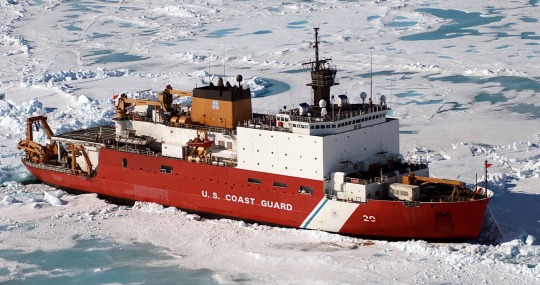
U.S. Coast Guard Cutter Healy (WAGB-20) sits approximately 100 miles north of Barrow, Alaska, in order to conduct scientific ice research. © Wikipedia/U.S. Coast Guard/DoD
Besides that are three smaller icebreakers used by the National Science Foundation, an independence federal agency engaged in research into all non-medical fields of science. Its ships, built in the 1990s and mid-2010s, include the Nathaniel B Palmer, the RV Laurence M. Gould and the RV Sikuliaq. These vessels operate comfortably in between 0.3 (the Gould) and 0.75 meters (the Sikuliaq) of ice. The Gould and the Palmer are typically stationed in Antarctic waters, while the Sikuliaq, an indigenous word meaning ‘young sea ice’, operates off Alaska.
The Coast Guard has ambitious plans for expansion, expecting to get three new heavy icebreakers, and three medium ones, in the coming years and decades. Delivery of the first ship of the new fleet has been delayed from 2024 until at least 2027, with the service requesting $125 million for the purchase and modification of a commercially available polar icebreaker built in the USA to bridge the gap as the flagship Polar Star rapidly approaches the 50-years-old mark.
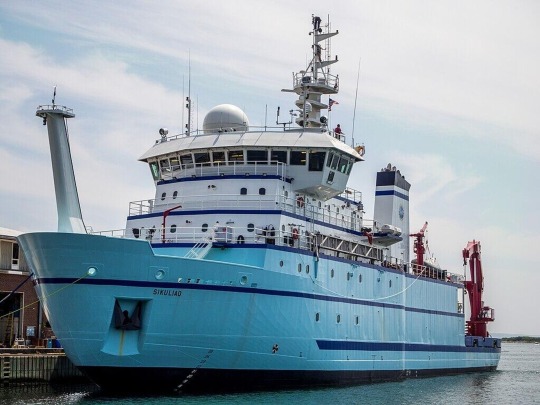
Icebreaking research vessel Sikuliaq in Woods Hole, Massachusetts. © Photo: James Buchanan
#4: Sweden 🇸🇪
Sweden, which does not have direct access to the Arctic from its coast, or any maritime territory above the Arctic Circle, nonetheless maintains an impressive fleet of icebreakers, mostly for patrolling the northernmost waters of the Gulf of Bothnia and in at least one case, a large inland lake. Sweden operates up to seven icebreakers, five of them – the Ale, the Atle, the Frej, the Oden and the Ymer, run by the Swedish Maritime Administration. The Ale is a 1,540 ton escort icebreaker, purpose built in the 1970s to sail in Lake Vanern, situated in southern Sweden about 150 km southeast of the border with Norway.

Sweden's Oden icebreaker pictured breaking up thick ice. © Photo: Swedish Maritime Administration.
The Atle, Frej and Ymer are Atle class icebreakers, built at the legendary Wartsila Helsinki Shipyard in Finland between 1974 and 1977. These ships are 104.5 meters long and displace 9,500 tons, and feature a dual rudder and dual bow propeller system that can crack ice at thicknesses of between 0.75 and 1 meters. The newest ship in Sweden’s icebreaker fleet is the Oden, a research vessel built in 1988 and originally tasked with escorting commercial vessels. The ship displaces up to 13,000 tons, and can power through ice up to 5 meters thick, with enough capacity to spare for operations in Arctic waters, pending supply support from a friend in the region. Sweden plans to built at least three new icebreakers, with the first expected to be delivered in 2027 at the earliest.
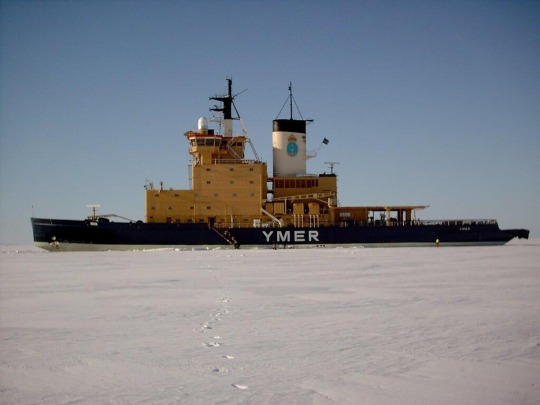
Sweden's Ymer icebreaker. © Photo: Marcus Bengtsson
#3: Finland 🇫🇮
Finland’s icebreaker fleet packs a surprisingly strong punch, facilitated by the country’s northern geography, and decades of successful shipbuilding cooperation and sales to its neighbors, Sweden and Russia. The country’s fleet, which includes nine major icebreaking ships, plus one icebreaking-capable special-use ship operated by the Navy, includes the oldest ships in this list: The Voima, commissioned all the way back in 1954, and refit in the late 1970s and again in 2016, is classed as an 1A Super icebreaker, enabling it to break up sea ice up to 1.2 meters thick at speeds of 2 knots.
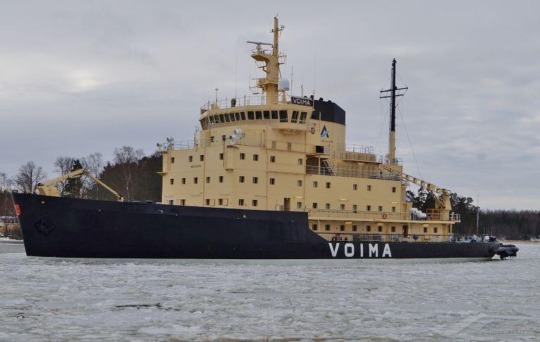
The Voima icebreaker, one of the oldest known icebreakers in operation. © Photo: Pekka Jarvinen
The Urho and Otso-class (two ships each) displace 9,660 tons and 9,222 tons, respectively, and were built in the 1970s and 1980s to operate in Gulf of Bothnia and Gulf of Finland waters, where ice can reach up to 45 cm thick during winter. The Navy-operated ship is called the Louhi, is owned by the Finnish Environmental Institute, and is classified as an oil and chemical spill response vessel. The ship has a 3,450-ton displacement, and can penetrate ice ridges up to an impressive 5 meters thick, while operating at speeds up to 9.5 knots in 1-meter thick ice.
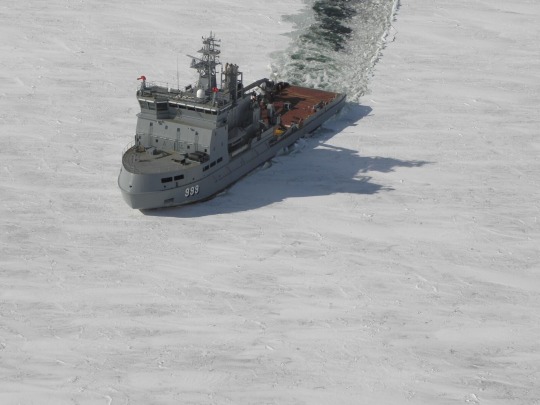
The Louhi, a unique Finnish multipurpose vessel design by ILS Oy Ship Design & Engineering with impressive icebreaking capabilities. © Photo: ILS Oy Ship Design & Engineering
#2: Canada 🍁 🇨🇦
Canada, Russia’s Arctic neighbor to the north, has an Arctic coastline stretching a whopping 162,000 kilometers thanks to 94 major and 36,400+ minor islands covering a territory of some 1.4 million square kilometers. That makes a large and diverse icebreaker fleet essential for assuring the country’s sovereign claims. Canada’s Coast Guard operates at least 15 icebreakers (about half of them capable of operations in the far north), at least three icebreaker/tug/supply vessels purchased from Sweden, and two offshore patrol vessels with icebreaking capabilities operated by the Navy.
The flagship of Canada’s icebreaking fleet is the Louis S. St-Laurent, a massive, 15,324 ton heavy icebreaker commissioned in 1969 and undergoing refits in the late 1980s and 2000, with room for two Bell 429 helicopters onboard and enough space to comfortably supply 46 crew for over 6 months at a time. The ship can break through ice between three and five meters thick, with its ice horn designed to protect the rudder.
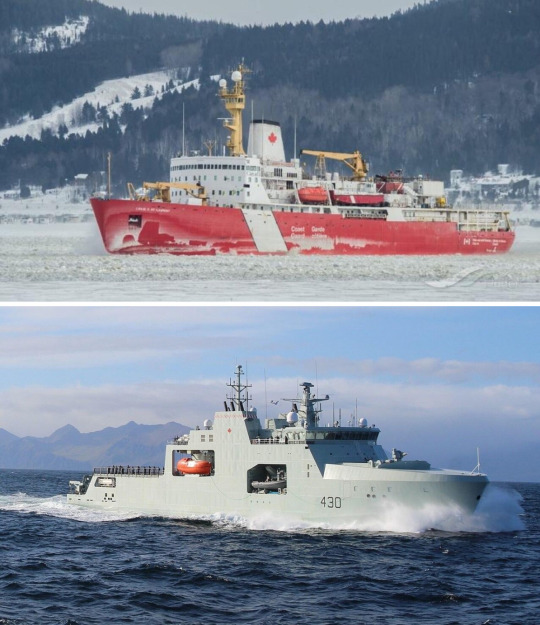
Top: Louis S. St-Laurent, the flagship and pride of the Canadian Coast Guard's icebreaker fleet. © Photo: Serg Tremblay Bottom: HMCS Harry DeWolf on patrol in Dutch Harbor, September 2021. © Photo: US Coast Guard
Other prominent vessels in the fleet include four ships of the Pierre Radisson-class of medium icebreakers, which weigh 8,180 tons fully loaded and can plow through ice a meter thick at speeds up to 6 knots, and the Martha L. Black class – featuring six light icebreakers built in the 1980s weighing about 4,740 tons full load, and operating off British Columbia, Quebec, Newfoundland and Labrador, and Nova Scotia.
The Canadian Navy’s icebreaking-capable warships including the HMCS Harry DeWolf and the HMCS Margaret Brooke, which can slash through first-year sea ice up to 120 centimeters thick.
#1 Russia 🇷🇺
Dwarfing the rest of the countries in this list, with more icebreakers than the rest of the planet put together, is Russia, whose fleet includes about 45 large icebreakers (seven of them nuclear-powered), well over a dozen off-shore icebreaking anchor-handling tug supply vessels, at least seven icebreaking-capable warships, and three research and survey vessels.
The nuclear-powered portion of the fleet includes the Yamal, the 50 Let Pobedy, the Taymyr, the Vaygach, and the brand new Project 22220 series Arktika, Sibir and Ural vessels, which were commissioned in 2020, 2021 and 2022, respectively (the fourth ship, the Yakutiya is set to join them this year, while the Chukotka, Leningrad and Stalingrad are expected by 2030). These massive, 173.3 meter-long ships have a complement of 75, helideck and hangar, and are propelled by two RITM-200 175 MWt-apiece nuclear reactors and twin turbo generators, allowing them to accelerate to speeds of up to 22 knots through open waters, or 1.5-2 knots in ice 2.8 meters thick (with the ability to operate in ice up to 4 meters thick at slower speeds).
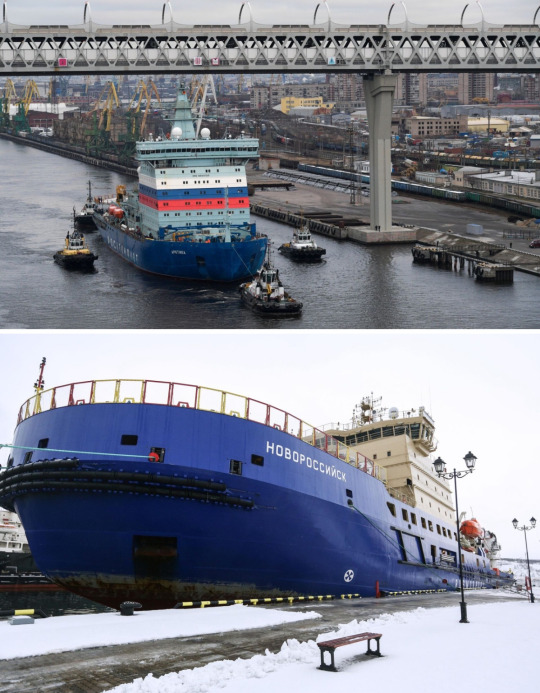
Top: Russia's Arktika-series nuclear-powered icebreaker being pulled along by tugs in a shipyard. © Sputnik/Aleksander Galperin/Go to the mediabank Bottom: Project 21900M diesel-electric icebreaker Novorossiysk in the harbor in Murmansk. © Sputnik/Pavel Lvov
Russia owes its nuclear icebreaking prowess to the Lenin, the world’s first nuclear-powered icebreaker, commissioned in 1959 and turned into a museum ship permanently docked in Murmansk in 1989.
An even larger icebreaker, the Project 10510 Rossiya, which is 219 meters long and displaces nearly 70,000 tons, will be able to crack through 4-meter thick ice with ease, and leave a large, 47.7 meter-wide path for any ships it happens to be escorting. The ship’s 127-person crew will be able to operate non-stop for up to 8 months at a time, enough to ensure comfortable year-round for operations through Russia’s Northern Sea Route passage.
Diesel-powered ships in the Russian icebreaking fleet include the Admiral Makarov, a veteran scientific and supply ship commissioned in 1975, seven ships total of the Kapitan Sorokin and Mudyug-class icebreakers built for the USSR by Finland in the 1970s and 1980s, and the new Project 21900 ships, the Moskva and the Sankt-Peterburg, built in 2008 and 2009, respectively. The latter displace 14,300 tons, and crack through ice up to 1.5 meters. A modernized model of the Project 21900, Project 21900M, has been built from 2015 onward, and includes the Vladivostok, Murmansk and Novorossiysk. Two more, the Arkhangelsk and the Vyborg, are on the way and may be delivered as soon as this year.
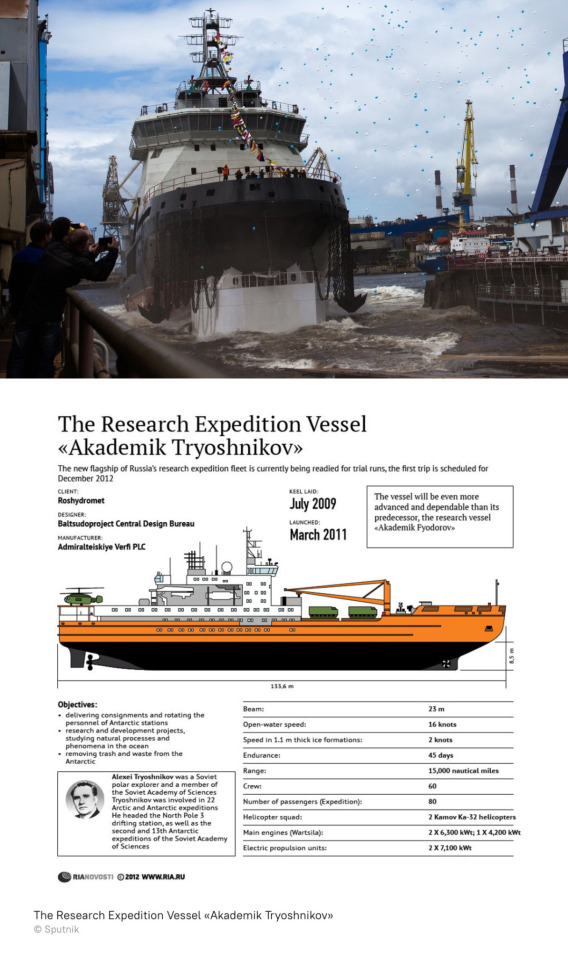
Top: The new generation diesel-electric icebreaker Ilya Muromets being launched into the water from its drydock. © Sputnik/Igor Russak/Go to the Mediabank
The Russian Navy’s complement of icebreakers includes the Ilya Muromets, a 6,000 ton-displacement vessel commissioned in 2017 featuring a unique contra-rotating propeller design, and the Evpatiy Kolovrat, which displaces 4,080 tons, and is expected to be commissioned by the Pacific Fleet later this year. The ships are expected to facilitate naval operations in ice up to 1.5 meters thick.
Finally yet importantly are Russia’s active icebreaking research ships, the Mikhail Somev, Akademik Fedorov and Akademik Tryoshnikov, built between the mid-1970s and the early 2010s. These vessels are between 133.5 and 141 meters long, displace between 16,200-16,500 tons, and are classed for independent operations through ice between 1.4 and 3.2 meters thick. Scientists the world over owe much of our fundamental knowledge about the most remote regions of the Arctic and Antarctic to Soviet and Russian icebreaking research ship technology, and to the many thousands of researchers and scholars who have worked aboard them over the decades.
— Ilya Tsukanov | Sputnik International | Sunday February 11, 2024
#World 🌎 | Russia 🇷🇺 | Sweden 🇸🇪 | Arctic 🐻❄️ 🥶 | Coast Guard | Navy#United Nations Convention on the Law of the Sea (UNCLOS) USCGC Healy | Sibir | Finland 🇫🇮 | US 🇺🇸#Icebreaker#Canada 🍁 🇨🇦
0 notes
Text
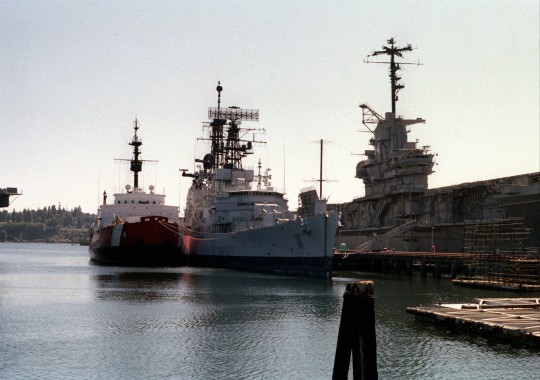
Laid up at the Naval Inactive Ship Maintenance Facility at Puget Sound Naval Shipyard are, from left to right, USCGC GLACIER (WAGB-4), USS OKLAHOMA CITY (CG-5) and USS ORISKANY (CV-34).
Photographed by LT Fallon on January 25, 1990.
NARA: 6450777
#USS Oriskany (CV-34)#USS Oriskany#Essex Class#Aircraft Carrier#USS Oklahoma City (CG-5)#USS Oklahoma City#Galveston Class#Guided Missile Cruiser#Cruiser#USCGC Glacier (WAGB-4)#USCGC Glacier#Icebreaker#warship#ship#mothballs#reserve fleet#January#1990#united states navy#us navy#navy#usn#u.s. navy#my post
75 notes
·
View notes
Photo


i needed to practice clean(ish) lineart so i doodled stuff from two fics!! the first is I Guess We’re The Same by @heeyitsmk and the second is We All Get Burned by @terwho
#mob psycho 100#mp100#terumob#igwts#wagb#the full title of igwts is i guess we're the same so don't leave me behind#but thats very long so i didn't type the whole thing out#ANYWAY igwts is ageswap terumob and its VERY CUTE although mk assures us the angst is coming#and wagb is like... 2 years from canon#and it features teru having a very bad time#CHECK THEM BOTH OUT THEY ARE VERY GOOD FICS AND I LOVE BOTH OF THE AUTHORS WITH ALL OF MY HEART#my art#(disclaimer. the igwts drawing hasnt actually happened in the fic yet)#(im sure it will)#(but it hasnt)#(theyre both still pining like lovesick fools)
376 notes
·
View notes
Text

69 notes
·
View notes
Photo

🔶~* Classical Ballet Variations, Vol. 1 *~ ° ° This CD contains 16 useful pieces of music for BALLET VARIATIONS , a special selection for Male and Female. ° 🔷TRACKS: 1. Harlequinade Male Variation 2. Prince Désiré Variation 3. Don Quixote Male Variation 4. Franz Variation 5. Genzano Male Variation 6. Paquita Male Variation 7. La Sylphide James Variation Act 1 8. Grand Pas Classique Male Variation 9. Genzano Flower Festival Female Variation 10. Paquita Female Variation from Pas de Trois 11. Swanila Variation Dance de Fête 12. Blue Bird Variation 13. Medora Variation 14. Swan Lake Pas de Trois Female Variation 15. Paquita Female Variation 1 16. Grand Pas Classique Female Variation 🔷AVAILABLE ON: Amazon, Apple Music, ITunes, Spotify, Google Play Music, YouTube, Deezer, Tidal and other digital platforms. 🔷LINKS IN BIO! 😉🆙💃🎶 ° ° ° #balletmusicch #ballet #ballett #loveballet #balletlife #brunoraco #balletvariations #prixdelausanne #youthamericagrandprix #worldballetartcompetitiongrandprix #shanghaiibc #wagb #ibcc #mibc #harlequinademalevariation #princedésirévariation #donquixotemalevariation #franzvariation #genzanomalevariation #paquitamalevariation #lasylphidejamesvariationsct1 #grandpasclassiquemalevariation #genzanoflowerfestivalfemalevariation #paquitafemalevariationfrompasdetrois #swanilavariationdancedefête #bluebirdvariation #medoravariation #swanlakepasdetroisfemalevariation #paquitafemalevariation1 #grandpasclassiquefemalevariation https://www.instagram.com/p/B8YR559g_94/?igshid=8xfbawiuokoa
#balletmusicch#ballet#ballett#loveballet#balletlife#brunoraco#balletvariations#prixdelausanne#youthamericagrandprix#worldballetartcompetitiongrandprix#shanghaiibc#wagb#ibcc#mibc#harlequinademalevariation#princedésirévariation#donquixotemalevariation#franzvariation#genzanomalevariation#paquitamalevariation#lasylphidejamesvariationsct1#grandpasclassiquemalevariation#genzanoflowerfestivalfemalevariation#paquitafemalevariationfrompasdetrois#swanilavariationdancedefête#bluebirdvariation#medoravariation#swanlakepasdetroisfemalevariation#paquitafemalevariation1#grandpasclassiquefemalevariation
0 notes
Text
U.S. Coast Guard Heavy Icebreaker USCGC Polar Star Arrives in Dutch Harbor, Alaska for First Visit Since 2013
#USCoastGuard's sole operational heavy icebreaker USCGC Polar Star arrives in Dutch Harbor, #Alaska for first visit since 2013. #USCGCPolarStar #WAGB10
The U.S. Coast Guard’s sole operational Polar-class heavy icebreaker, USCGC Polar Star (WAGB 10) arrived in Dutch Harbor, Alaska on Tuesday (Jan. 5) for a logistics stop for the first time since 2013. The 44-year-old heavy icebreaker is now around 30 days into a months-long Arctic deployment “to protect the nation’s maritime sovereignty and security throughout the polar region”. The icebreaker is…

View On WordPress
#Alaska#Arctic#Icebreaker#Polar-class icebreaker#U.S. Coast Guard (USCG)#USA#USCGC Polar Star (WAGB-10)
1 note
·
View note
Video
USCG HTL-7 Sioux by G. Verver Via Flickr: USCGC Northwind (WAG/WAGB-282) and HTL-7 Sioux in 1962. One of two USN HTL-7's from BuNo's 145837-145854, later redesignated TH-13N, and named Snoopy and Red Baron. The recently installed telescopic hangar seen here in retracted position was designed to give the helicopters full protection from the extreme weather and from corrosion from the salty air, as well as protection for the maintenance crew.
3 notes
·
View notes
Text

Orcas salute
Three orcas surface for air in a gap in the ice made by the ship USCGC Polar Sea (WAGB-11) in Antarctica.
(Photo by Bryan Goff)
0 notes

